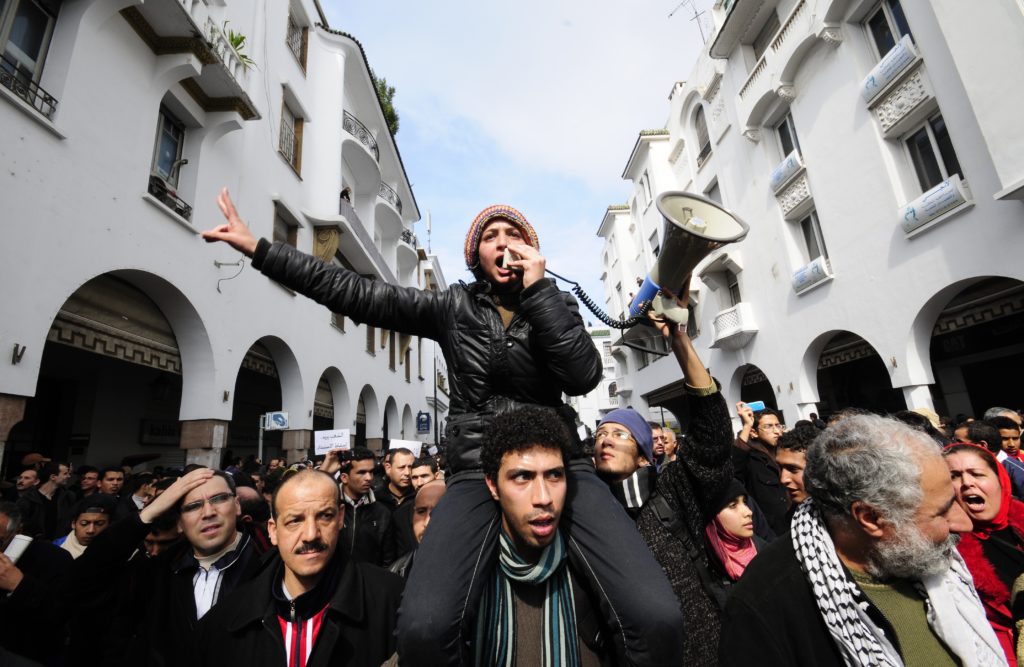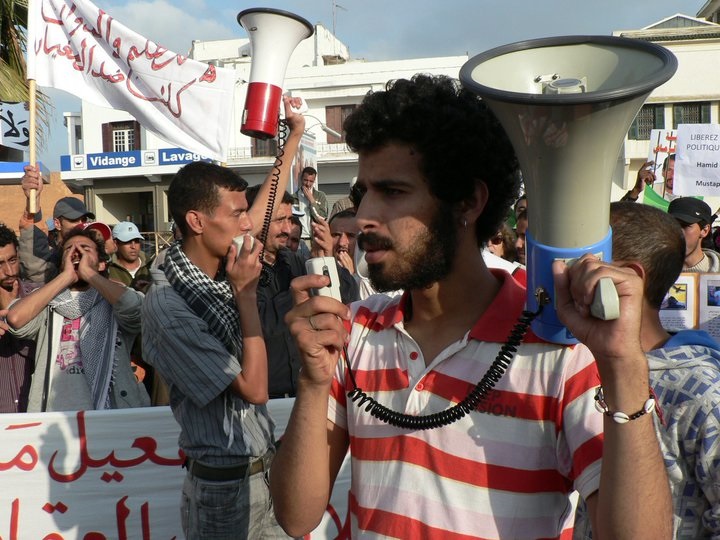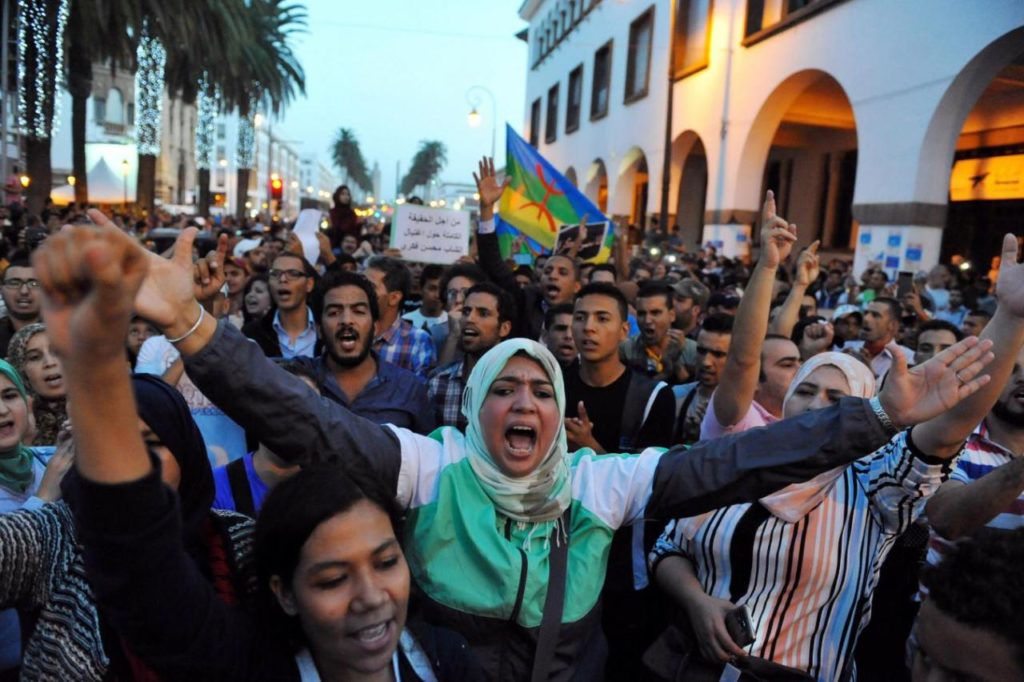
Last month marked the seventh anniversary of the February 20 Movement, a pro-democracy movement born in Morocco in the wake of the Tunisian and Egyptian revolutions. To celebrate the anniversary of one of the most defining events of Morocco’s recent political history, hundreds of protesters took to the streets in Casablanca, Rabat, Nador, Fes and other Moroccan cities.
These demonstrations took place without incident. However, in Nador, a city in the Rif region, where a protest movement against corruption and for regional development was highly active from 2016 to 2017, authorities were edgy. According to local activists, a heavy police presence prevented people from gathering to mark the February 20 Movement anniversary, and at least five protesters were briefly detained by police.
In Rabat, Morocco’s capital, about 300 people reaffirmed the movement’s call for democracy and demanded the release of the 400 detainees arrested in the connection with the Hirak, a social movement in the Rif. Activist participating in the Rabat mobilization included members from the anti-neoliberal NGO ATTAC Maroc, the Moroccan Association of Human Rights (AMDH), the Marxist-Leninist party Annahj Addimocrati (The Democratic Way), the Socialist Democratic Vanguard Party (PADS), and the youth of the Unified Socialist Party (PSU).
As the sit-ins ended and the activists left the streets, the atmosphere was not one of celebration. The protests are not strong enough anymore to exert pressure and shake Morocco’s political establishment. Many activists did not show up at all, while others came just to meet and talk with other activists, without any political objectives.
Most of the founding members of the movement have not protested for years. The street dynamic is not in their favor, they say. The movement has been weakened by years of state repression. Other former leaders believe that without any popular support and a new and clear agenda, the small protests – involving hundreds rather than the hundreds of thousands of people at the movement’s peak – only weaken the activists’ sphere of political influence.
Abdullah Abaakil, now a member of the Unified Socialist Party, was deeply involved in the Casablanca coordination of the February 20 Movement in 2011. According to him, the movement now belongs to the past. “I don’t have a nostalgic nature,” he said. “I demonstrate for the future, not to contemplate a glorious past.”
For the few who remain committed to making their voices heard, the very failure of the February 20 movement to have its demands met is a motivation to keep up the pressure, even though Morocco’s streets are empty.
Ilias Lakhlifi, a law student, has been taking part in student protests since high school and joined the Marxist-Leninist party Annahj Addimocrati in 2007. He’s been participating in the February 20 Movement since the first day.
“I’m protesting because nothing has changed,” he said. “The human rights situation as well as the economic and social one has worsened. The street is the center of pressure to make change. We must continue to demand change.”
“The repression is there because the street is weak,” he continued. “We have to gather and come up with a way to come back to the streets.”
Hassan Maaras, one of the founding members of the Rabat coordination of the movement and a member of the AMDH, attended an anniversary protest in Agadir, in southern Morocco, where he lives now. “The reasons we took to the streets in February 2011 are still there,” he said. “We went out to ask for the fall of dictatorship, for freedom, social justice.”

In 2011, people from diverse political tendencies and ideologies, from the radical left to Islamists, gathered under the same banners. Weakened by repression, internal divisions and political power grabs by the state as well as political parties, the biggest protest movement in the country’s recent history now only attracts annual gatherings of members of leftist parties, a few Maoists and Trostkist activists, and independent protesters not affiliated to any political current.
However, the February 20 Movement’s achievements are far from modest. Although most activists agree the movement failed to bring any major political change, they insist on a major legacy: a vibrant and bold culture of protest, one which has reached out to the most remote areas of the country.
Each day, dozens of demonstrations, marches or sit-ins take place in the country, whether it is in Zagora, in the south of Morocco, to call for health infrastructure and access to water, or in Jerada, in the northeast, to demand an economic alternative, jobs, healthcare, and education, particularly following the tragic deaths late last year of two miners in illicit coal mines.
“People are not afraid anymore,” said human rights activist and trade unionist Abdellah Lefnatsa. “Everywhere, the population takes its inspiration from the February 20 Movement to express demands. The movement inspires all social movements, in El Hoceima, Jerada… The movement is not dead. But now it is the people who carry on and get out.”
Lefnatsa was in front of Morocco’s parliament on the February 20 Movement anniversary to celebrate what he believes was a historical achievement. The movement, he said, forced the Moroccan regime to make major concessions. “Since Morocco’s independence, no political movement has succeeded in putting enough pressure to obtain the slightest amendment to the Constitution. And trade unions, even when all united, have never been able to put enough pressure to obtain such wage claims. All it took was the youth of the movement going out for the state to give a raise of 600 Dirhams (about 65 USD) to civil servants.”
On February 20, 2011, tenth of thousands of people took the streets of Morocco in 53 cities to call for political and social change. Their main slogan, still heard today in the numerous social movements born since throughout the country: “Liberty, dignity, social justice”.
The founding document of the Rabat coordination of the movement, released before the first day of national protests, called for a democratic constitution with a real separation of powers, the fall of the government, the dissolution of parliament, the release of all political prisoners, and an end to Morocco’s widespread corruption.
Less than three weeks after the first day of protests, on March 9, 2011, King Mohamed VI announced a constitutional change. The elections in the fall of 2011 were won by the Islamist party Justice and Development (PJD), a party that had never been in the government, and which coopted some of the language and momentum of the February 20 Movement. The PJD demanded an end to corruption, while at the same time opposing and criticizing the February 20 Movement itself.
Within this climate, the Moroccan state tried to clamp down on the movement and prevent its expansion. It nevertheless grew until May 2011, with demonstrations in over 115 cities. In May of that year, the repression and the defamation against activists intensified and the movement never bounced back.

Since that time, however, some uprisings have taken place. In August 2013, protests in several cities led to the withdrawal of a royal pardon granted to a Spanish pedophile, an unprecedented move. The wall of fear has continued to dissipate, in spite of the weakening of the movement and a continuous crackdown that has led, according to the AMDH, to more than two thousand arrests in the last seven years. Among them, the AMDH said at least three hundred have been jailed in connection with the movement.
Last May, another wave of arrests took place to silence the Hirak, a movement with social and economic demands similar to that of the February 20 Movement, but without any clear political objectives. It was born in October 2016 in El Hoceima, in the Rif, after Mohsine Fikri, a fishmonger, was crushed to death in a garbage truck while trying to retrieve merchandise local authorities had confiscated from him.
Lakhlifi, who took part to the first sit ins of the Hirak in the Rif, points out the links and similarities between the two movements, mainly through the protest chants and slogans against corruption. The activists also carry the struggle from one movement to the other. In the Rif, many young people took part to the February 20 Movement and later participated in the Hirak, with several former detainees recently released going back to jail.
In spite of this unprecedented repression, Lefnatsa sees hope in a change in mentalities and a rise in political consciousness. “The February 20 Movement has moved from the center to the periphery. It started here but now there is a decentralization of the spirit of the movement and it is the periphery that takes the forefront.”
The movement as it started does not exist anymore, but it left a legacy, Abaakil pointed out. “The most important,” he said, “is the network of activists who remain mobilized and act on occasion.”
Ilhem Rachidi is a freelance reporter based in Morocco. Rachidi has written extensively on protest movements and human rights issues, publishing articles in the French newspaper Mediapart (where she has worked as a correspondent for four years), Rue89, Al Monitor, and The Christian Science Monitor.
See these related Toward Freedom reports on Morocco by Ilhem Rachidi:
The Press and the Palace: Moroccan Journalists Denounce Government Crackdown on Media
The Hirak: A Moroccan People’s Movement Demands Change From the Streets
